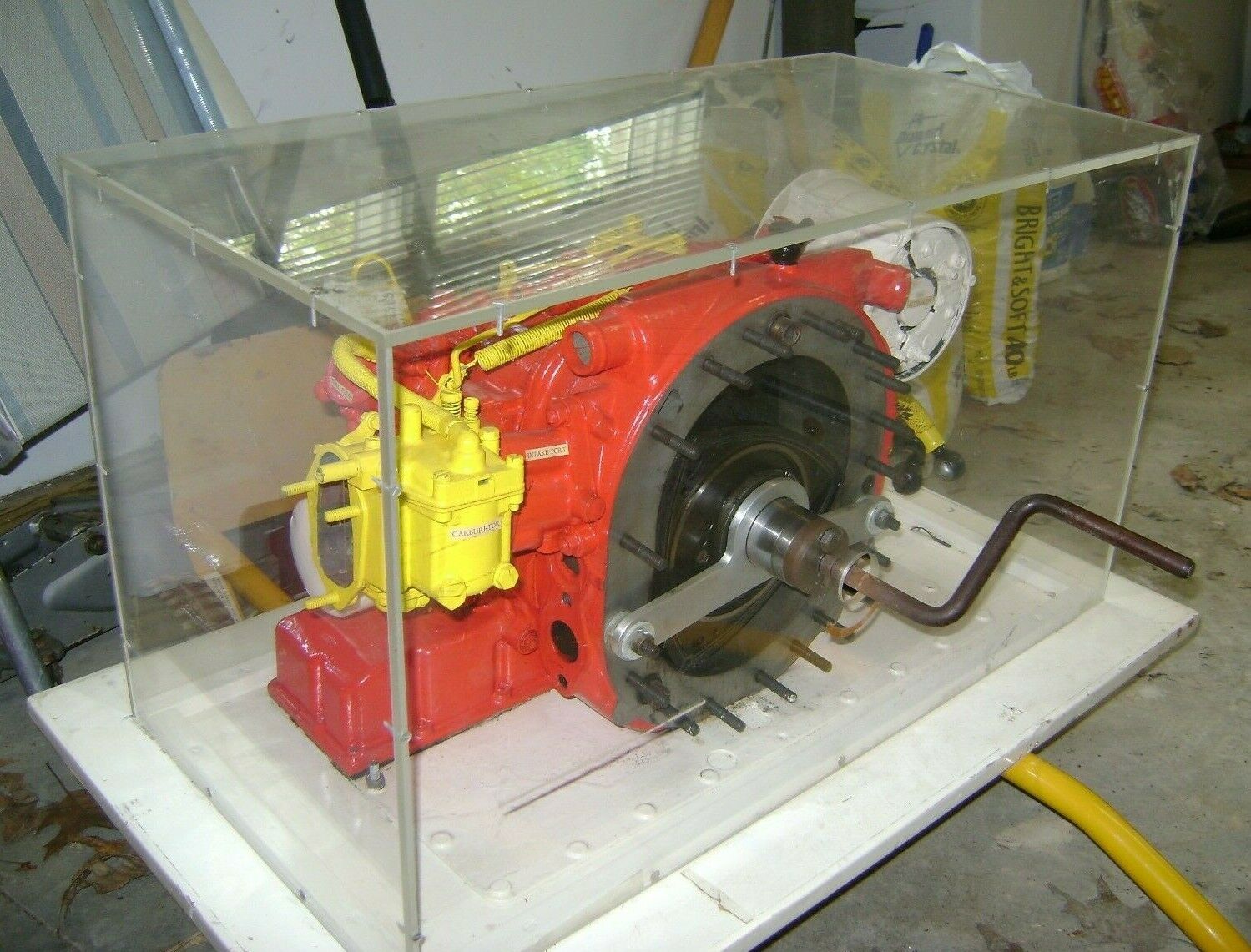-40%
RARE NSU Spider Wankel Rotary Engine Cutaway Display Exhibit Demonstration Model
$ 2006.4
- Description
- Size Guide
Description
Very Good used condition, sold as pictured intended for display, but parts appear in New OEM condition, plexiglass museum display case hasscratches and
small crack in LH panel
USPS shipping to continental destination only
NSU
Spider
Wankel Rotary Engine Cutaway Display
Exhibit
Demonstration Model
Full Size w/Case
1964-1967 NSU Wankel Spider Engine
This model appears to be based on the version used in the NSU Wankel Spider sports car (1964–1967).The exhibit
has a crank that lets you turn the rotor behind the
plexiglass,
the fan belt in the front also moves when you turn the crank.
Measures
30" x 18.5" x 16"
Weighs about 135 lbs.
About the
1964-1967 NSU
Wankel Spider Engine
Though Mazda is the manufacturer most closely associated with rotary engines, the Japanese automaker didn’t pioneer the unconventional engine’s use in an automobile. That honor goes to a manufacturer that’s now nearly forgotten, NSU, which worked with inventor Felix Wankel to develop the small-but-formidable power plant for automotive use. Its breakthrough car, the NSU Spider, was never meant to be more than a rolling testbed for the rotary engine, as well as a real-world advertisement for other automakers to license the technology. As a sports car, the 1964-1967 NSU Spider was a commercial failure, but as a car that gave a glimpse into an all-too-brief automotive future, it was groundbreaking.
Felix Wankel never had the benefit of a formal education, but that proved to be of little consequence for the engineering genius. In 1922, at the age of just 22, Wankel began sketching ideas for a new type of engine, one with fewer moving parts and lacking the violent stop-and-go reciprocating motion of pistons and connecting rods in a conventional engine. Designing such an engine from a clean sheet of paper proved to be a monumental task, and Wankel reportedly went through an estimated 800 shapes and 150 configurations before settling on a single design. By 1936, Wankel had been granted his first patent for the engine, but translating that into interest from automakers took decades longer.
NSU first took an interest in Wankel’s engine design to power its motorcycle product line. In addition to being compact and light, the rotary engine produced power equivalent to a piston engine roughly twice its displacement, and delivered its torque in a smooth and linear fashion. It didn’t take long for NSU management to realize such an engine had applications in the automotive realm as well, and by the mid-1950s, work was under way to develop a version of the Wankel rotary engine for use in an NSU automobile.
Underneath, the NSU Spider used four-wheel independent suspension, consisting of coil springs, shock absorbers and unequal-length A-arms up front and semi-trailing A-arms in the rear. The 12-inch wheels were stopped by front disc and rear drum brakes, and to further improve handling, an anti-roll bar was used up front. NSU Spiders were raced (primarily in Europe) with some degree of success, as the car’s half-liter rotary engine could be tuned to produce as much as 100 horsepower in Rennsport versions (where engine life was an insignificant factor).
As for amenities, the NSU Spider was well-equipped by sports car standards of the day. Side windows rolled up, and were made of glass, not thin transparent plastic. Seats were comfortable and well-padded, and the compact rotary engine allowed the Spider to offer both front and rear trunk spaces. While the soft top was standard, buyers could also opt for an accessory hard top to further extend the NSU’s functionality in cold climates.
In the United States, the NSU Spider was priced less than ,000, making it comparable to an MGA or Triumph TR4. As the rotary engine was still an unproven commodity, few consumers were eager to act as beta testers for the NSU factory, and dealers sold only 215 in the U.S. market. Worldwide, sales totaled 2,375 over the car’s four years of production, but that was enough for NSU to introduce a more powerful rotary-engine sedan called the NSU R0 80 for the 1967 model year. Though it earned “Car of the Year” honors in Europe in 1967, problems with apex seal failures continued to dog NSU, driving up the automaker’s warranty costs. With both profits and reserves dwindling, NSU and Auto Union were acquired by Volkswagen in 1969, then merged into the automaker we know today as Audi.
Mazda, which licensed the rotary engine technology from NSU (and nearly beat the Germans to market with its first rotary-powered car, the Cosmo), would go on to achieve reasonable success with the engine, albeit in niche markets. From the 1960s through the RX-8’s demise in 2012, Mazda dealers almost always had a pistonless offering for consumers, but emission regulations and the financial realities of building a low-volume, low-profit engine have halted the further development of the rotary engine (for now, anyway).
Some believe that the future of the series hybrid automobile (like the Chevrolet Volt) lies with generators powered by light and compact rotary engines, tuned for fuel economy instead of power. If that turns out to be the case, the NSU Spider may well be remembered as the car that heralded the future, decades before it came to pass.




















